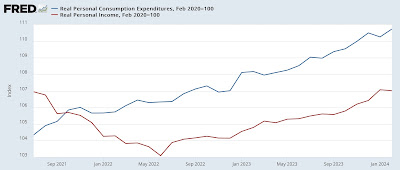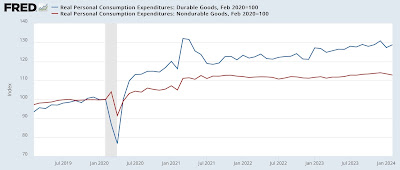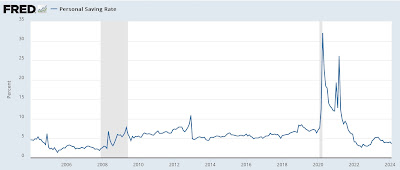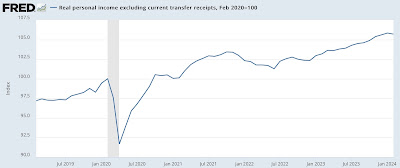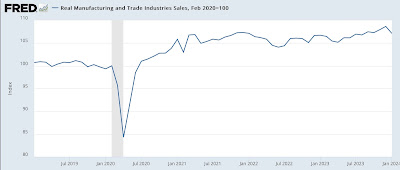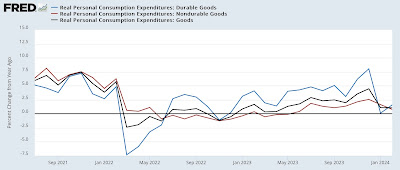– by New Deal democrat The Bonddad Blog Personal income and spending has become one of the two most important monthly reports I follow, because it nets out the impacts of higher interest rates and abating inflation due to the unlinking of the supply chain. To repeat, the big question this year is whether the contractionary effects of Fed tightening have just been delayed until this year. Or whether the fact that there have been no rate hikes since last summer mean that the expansion will strengthen. Because real personal spending on services for the past 50 years has generally risen even during recessions, the more leading components of this report have to do with spending on goods. Additionally, there are several components that form part
Topics:
NewDealdemocrat considers the following as important: Hot Topics, personal income and spending, US EConomics
This could be interesting, too:
NewDealdemocrat writes JOLTS revisions from Yesterday’s Report
Joel Eissenberg writes No Invading Allies Act
Bill Haskell writes The North American Automobile Industry Waits for Trump and the Gov. to Act
Bill Haskell writes Families Struggle Paying for Child Care While Working
– by New Deal democrat
Personal income and spending has become one of the two most important monthly reports I follow, because it nets out the impacts of higher interest rates and abating inflation due to the unlinking of the supply chain. To repeat, the big question this year is whether the contractionary effects of Fed tightening have just been delayed until this year. Or whether the fact that there have been no rate hikes since last summer mean that the expansion will strengthen.
Because real personal spending on services for the past 50 years has generally risen even during recessions, the more leading components of this report have to do with spending on goods. Additionally, there are several components that form part of the NBER’s “official” toolkit for determining when and whether a recession has begun, including real spending minus government transfers, and real total business sales.
In February, nominally income rose 0.3%, while nominal spending rose a sharp 0.8%. Prices as measured by the PCE deflator increased 0.3% for the month, meaning that in real terms income were unchanged and spending (after rounding) rose 0.4%. Since just before the pandemic real incomes are up 7.0%, and spending is up 10.7% (NOTE: Data in all graphs below except for YoY comparisons, and the personal saving rate, is normed to 100 as of just before the pandemic):
On a YoY basis, the PCE price index is up 2.5%, just above January’s three year low of 2.4%. In the previous 16 months, the YoY measure had been declining at the rate of 0.25%/month, suggesting that it would hit the Fed’s 2.0% target this spring:
This month’s slight increase is probably just noise due to rounding, as the monthly change in the YoY rate was only 0.02%.
As I indicated above, for the past 50+ years, real spending on services has generally increased even during recessions. It is real spending on goods which declines. Last month real services spending rose 0.6%, while real goods spending rose 0.1%:
As per form, real services spending has risen consistently since the pandemic, while goods spending has been somewhat of a mirror image of gas prices, which peaked in June 2022.
Real durable goods spending tends to turn before non-durable goods spending. The former rose 1.2% for the month, reversing about half of January’s very sharp decline, while the latter declined -0.6% for the second such drop in a row:
Durable goods spending had been very much affected over the past several years by the shortage of new vehicle inventory, which has largely abated as 2023 progressed.
Another important metric for the near future of the economy is the personal savings rate. In February it declined -0.5% from an upwardly revised January’s rate of 4.1% to 3.6%. This longer term look shows how the present compares with the all time low rate of 1.4% in 2005:
On the positive side, the declining trend in this rate since last May indicates a lot of consumer confidence. But on the negative side it remains close to the all time low readings of 2005-07, indicating vulnerability to an adverse shock. One of my forecasting models uses such a shock as a recession warning indicator. In any event, there is no such shock at the moment.
Also as indicated above, the NBER pays particular attention to several other aspects of this release. Real income excluding government transfers (like the 2020 and 2021 stimulus payments) declined -0.1% for the month, the first such decline since November 2022:
This has been something of a mirror image of gas prices, which not coincidentally have been rising sharply in recent weeks.
Finally, the deflator in this morning’s report is used to calculate real manufacturing and trade sales (with a one-month delay), another metric relied upon by the NBER. This declined sharply for January, by -1.4%, more than reversing December’s downwardly revised 0.7% increase:
I described last month’s report as being pretty close to “Goldilocks.” Well, this morning’s report for February was something of “anti-Goldilocks.” Real spending on durable goods is off peak for the second month in a row. Inflation YoY did not decelerate further. Real business sales also declined sharply. Spending rose – the most significant continued positive in the report – because consumers went into their savings.
While, as I noted above, it could just be noise, there is some evidence of a real slowing in YoY spending on goods in general and durable goods in particular:
As this has historically been the first sign of consumer distress, it will need to be watched extra carefully.
January personal income and spending: Goldilocks is knocking at the door, Angry Bear, by New Deal democrat

